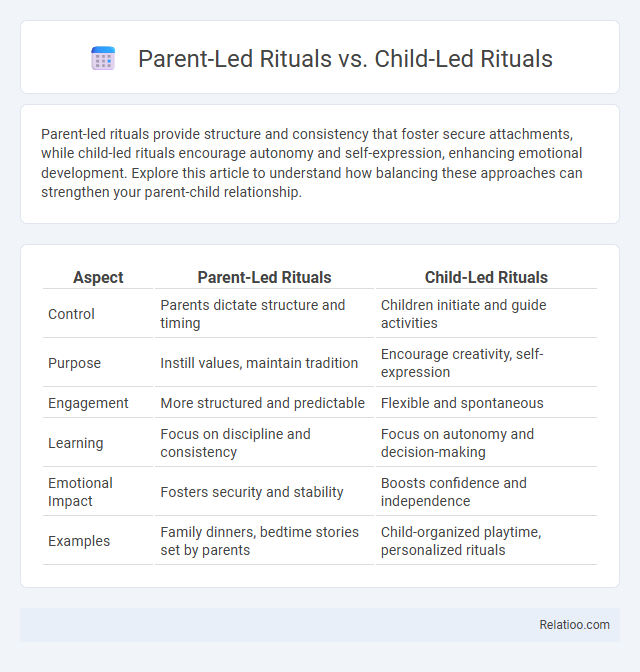Parent-led rituals provide structure and consistency that foster secure attachments, while child-led rituals encourage autonomy and self-expression, enhancing emotional development. Explore this article to understand how balancing these approaches can strengthen your parent-child relationship.
Table of Comparison
| Aspect | Parent-Led Rituals | Child-Led Rituals |
|---|---|---|
| Control | Parents dictate structure and timing | Children initiate and guide activities |
| Purpose | Instill values, maintain tradition | Encourage creativity, self-expression |
| Engagement | More structured and predictable | Flexible and spontaneous |
| Learning | Focus on discipline and consistency | Focus on autonomy and decision-making |
| Emotional Impact | Fosters security and stability | Boosts confidence and independence |
| Examples | Family dinners, bedtime stories set by parents | Child-organized playtime, personalized rituals |
Introduction to Parent-Led vs Child-Led Rituals
Parent-led rituals involve structured activities initiated and guided by parents, designed to create stability and predictability in a child's environment. Child-led rituals emerge from the child's interests and choices, fostering autonomy and creativity while allowing personalized engagement. Understanding the distinctions between parent-led and child-led rituals is crucial for balancing guidance with independence in child development.
Defining Parent-Led Rituals
Parent-led rituals are structured activities initiated and guided by caregivers, designed to foster security, routine, and connection within a family environment. These rituals often include bedtime stories, mealtime routines, and holiday traditions, emphasizing consistent adult involvement to shape the child's experience. Unlike child-led rituals, which arise from the child's interests and imagination, parent-led rituals aim to provide stability and cultural transmission through deliberate adult direction.
Understanding Child-Led Rituals
Child-led rituals emphasize a child's autonomy, allowing them to guide the activities and structure based on their interests and emotions, fostering creativity and self-expression. Research indicates these rituals enhance emotional regulation, social skills, and a sense of security by validating the child's voice within the family dynamic. Unlike parent-led rituals, which are structured and adult-driven, child-led rituals adapt fluidly to the child's developmental needs, promoting engagement and intrinsic motivation.
Psychological Impact on Children
Parent-led rituals provide structure and reinforce security, promoting attachment and emotional regulation in children. Child-led rituals encourage autonomy and self-expression, fostering confidence and a sense of control in their environment. Rituals, when consistently practiced, enhance psychological well-being by reducing anxiety and strengthening family bonds through shared meaning.
Benefits of Parent-Directed Rituals
Parent-directed rituals establish consistent routines that promote emotional security and behavioral stability in children, enhancing their sense of safety and predictability. Your active involvement in these rituals fosters stronger parent-child bonds and encourages positive social and cognitive development. Research shows that structured, parent-led activities contribute to improved communication skills and emotional regulation in early childhood.
Advantages of Child-Driven Rituals
Child-driven rituals promote autonomy and creativity by allowing children to take the lead in establishing meaningful routines, which enhances their sense of ownership and engagement. These rituals support emotional development by fostering self-expression and helping children process experiences in a personalized way. When you encourage child-led rituals, your child gains confidence and a deeper connection to family traditions, strengthening bonds and promoting long-term well-being.
Challenges and Pitfalls of Each Approach
Parent-led rituals often face challenges such as resistance from children who may feel controlled or disengaged, limiting genuine emotional connection. Child-led rituals can struggle with consistency and structure, making it difficult for parents to reinforce desired values or routines effectively. Your goal is to balance these approaches to avoid pitfalls like power struggles in parent-led rituals and unpredictability in child-led ones.
Age Appropriateness and Developmental Stages
Parent-led rituals provide structure and security vital for infants and toddlers developing trust and attachment, while child-led rituals encourage autonomy and creativity, aligning with preschoolers' growing independence and cognitive skills. Rituals should be tailored to your child's developmental stage, considering their emotional and social needs to foster a sense of belonging and self-expression. Age-appropriate rituals enhance developmental milestones by blending guidance with opportunities for your child's active participation and decision-making.
Blending Parent and Child Initiatives
Blending parent-led rituals with child-led rituals creates a balanced routine that nurtures both structure and creativity in Your family's daily life. Parent-led rituals provide consistency and security, while child-led rituals encourage independence and personal expression. Combining these approaches fosters mutual respect and strengthens the emotional bond, promoting holistic development in children.
Choosing the Right Ritual Approach for Your Family
Choosing the right ritual approach for your family hinges on understanding the benefits of both parent-led and child-led rituals. Parent-led rituals provide structure and consistency, fostering security and shared values, while child-led rituals empower your child's creativity and encourage emotional expression. Balancing these approaches nurtures a cohesive family environment that supports development and strengthens bonds.

Infographic: Parent-Led Rituals vs Child-Led Rituals
 relatioo.com
relatioo.com